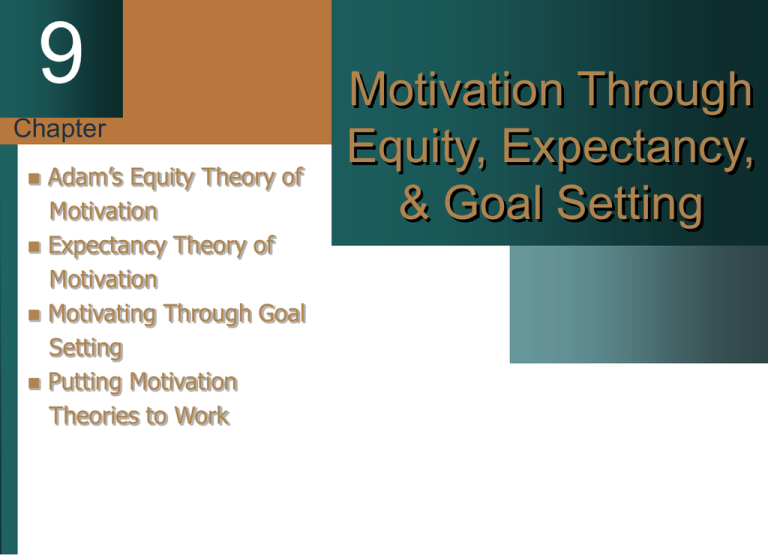
9
Chapter
Adam’s Equity Theory of
Motivation
Expectancy Theory of
Motivation
Motivating Through Goal
Setting
Putting Motivation
Theories to Work
Motivation Through
Equity, Expectancy,
& Goal Setting
Equity Theory
Argues
that believed fairness or unfairness
motivates behaviors at work
People strive for fairness and justice in social
exchanges
Cognitive dissonance – emotional tension
Factors Considered When Making
Equity Comparisons
9-4
Table 9-1 cont.
– everything the individual perceives
she or he brings to the job
Outcomes – everything the individual
perceives she or he receives from the job
Referent (comparison other) – another
person whose input:outcome ratio is used to
determine fairness
Inputs
McGraw-Hill
© 2004 The McGraw-Hill Companies, Inc. All rights reserved.
9-8
Equity Sensitivity
Equity
Sensitivity an individual’s
tolerance for negative and positive
equity
Benevolents
have a higher tolerance for
negative inequity
Sensitives adhere to strict norm of
reciprocity
Entitleds have no tolerance for negative
inequity
McGraw-Hill
© 2004 The McGraw-Hill Companies, Inc. All rights reserved.
9-11
Organizational Justice
Distributive Justice the
perceived fairness of how
resources and rewards are
distributed
Interactional Justice
extent to which people feel
fairly treated when
procedures are implemented
Procedural Justice the
perceived fairness of the
process and procedure used
to make allocation decisions
McGraw-Hill
© 2004 The McGraw-Hill Companies, Inc. All rights reserved.
9-12
Equity Research Findings
Job performance and counterproductive work
behaviors positively associated with distributive and
procedural justice
All three forms of justice were positively correlated
with job satisfaction, organizational commitment,
organizational citizenship behaviors, and employees’
trust
All three were negatively associated with employees’
withdrawal cognitions and turnover
Distributive and procedural injustice were related to
negative emotions
McGraw-Hill
© 2004 The McGraw-Hill Companies, Inc. All rights reserved.
9-13
Expectancy Theory of Motivation
Expectancy
Theory
holds that people are
motivated to behave in
ways that produce valued
outcomes
McGraw-Hill
Assumes people want to
maximize pleasure and
minimize pain
© 2004 The McGraw-Hill Companies, Inc. All rights reserved.
9-14
Vroom’s Expectancy Theory
Expectancy belief that effort leads to a specific level
of performance
Instrumentality a performance
outcome
perception
Valence the value of a reward or outcome
McGraw-Hill
© 2004 The McGraw-Hill Companies, Inc. All rights reserved.
9-15
Research shows
Employees’
expectancy perceptions are
influenced by:
Self-esteem
Self-efficacy
Previous success at the task
Help received from a supervisor and
subordinates
Information necessary to complete the task
Good materials and equipment to do work with
McGraw-Hill
© 2004 The McGraw-Hill Companies, Inc. All rights reserved.
9-21
Goals
Goal what an individual
is trying to accomplish
McGraw-Hill
Setting goals with
workers helps workers
focus on the inputs that
are necessary to achieve
the goal
© 2004 The McGraw-Hill Companies, Inc. All rights reserved.
9-22
Figure 9-3
Locke’s Model of Goal Setting
Directing
one’s attention
Regulating
one’s effort
Goals
motivate the
individual
by...
Task
performance
Increasing
one’s persistence
Encouraging the
development of goalattainment strategies
or action plans
McGraw-Hill
© 2004 The McGraw-Hill Companies, Inc. All rights reserved.
9-23
Figure 9-4
Goal Difficulty and Performance
B
High
Performance
A
C
Medium
Low
Low
Moderate
Challenging
Impossible
Goal Difficulty
A Performance of committed individuals with adequate ability
B Performance of committed individuals
C Performance of individuals who lack commitment to high goals
McGraw-Hill
© 2004 The McGraw-Hill Companies, Inc. All rights reserved.
9-24
Table 9-4
Insights from Goal Setting Research
1)
2)
3)
4)
5)
Difficult goals lead to higher performance
Specific, difficult goals lead to higher
performance for simple rather than complex
tasks
Feedback enhances the effect of specific,
difficult goals
Participative goals, assigned goals, and selfset goals are equally effective
Goal commitment and monetary incentives
affect goal-setting outcomes
McGraw-Hill
© 2004 The McGraw-Hill Companies, Inc. All rights reserved.






